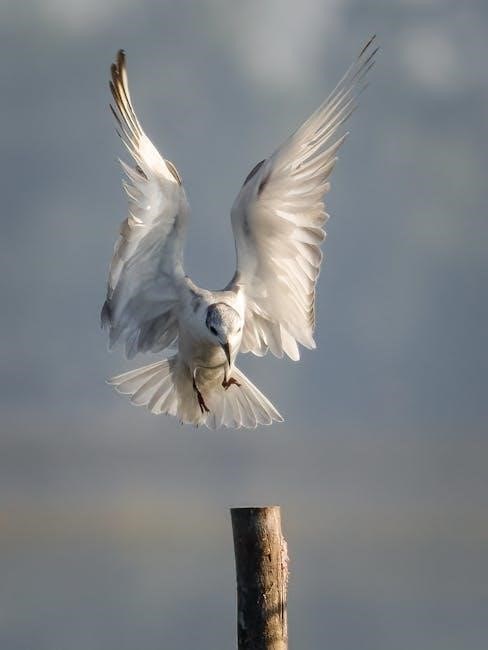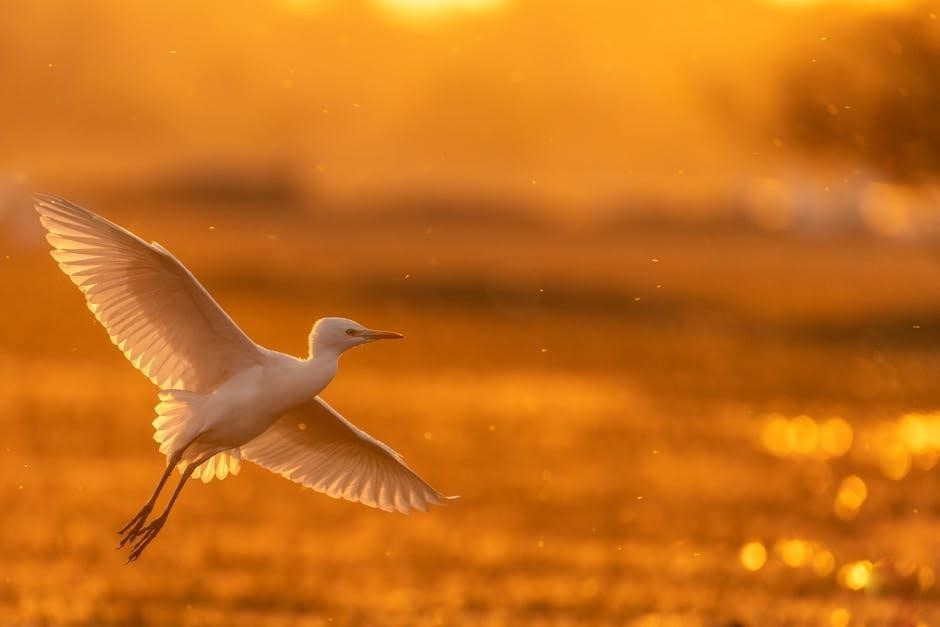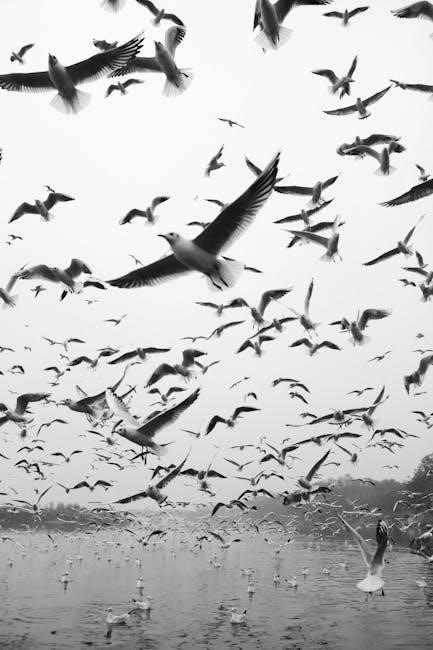Lord of the Flies, written by William Golding, is a thought-provoking novel published in 1954. It explores the story of British boys stranded on an island, revealing their descent into chaos. The book is a powerful allegory on human nature, civilization, and inherent evil, making it a timeless classic in world literature.
1.1 Overview of the Novel
Lord of the Flies is a gripping narrative about a group of British boys stranded on a remote island after a plane crash. With no adult supervision, they attempt to govern themselves, reflecting the broader aspects of human society. The novel delves into themes of power, fear, and the innate savagery within humans. As the story unfolds, the boys’ initial civilized behavior deteriorates, leading to chaos and violence. The island serves as a microcosm of the world, highlighting the fragility of morality and the effects of isolation. Through vivid characters like Ralph, Jack, and Piggy, Golding explores the clash between reason and instinct, culminating in a haunting commentary on human nature. The novel’s universal themes ensure its enduring relevance and appeal.
1.2 Author Background: William Golding
William Golding, born on September 19, 1911, in Cornwall, England, was a renowned English novelist, playwright, and poet. Before becoming a writer, he worked as a teacher and later served in the Royal Navy during World War II. His experiences during the war profoundly influenced his views on human nature, which are central to Lord of the Flies. Golding was forty-three when he wrote his debut novel, published in 1954. He became a Nobel laureate in 1983 and was knighted in 1988. His works often explore themes of morality, power, and the darker aspects of human behavior, cementing his legacy as a significant figure in 20th-century literature.
1.3 Historical Context and Publication Details
Lord of the Flies was published in 1954 by Faber and Faber in London and in 1955 in New York. Written by William Golding, the novel emerged in the post-World War II era, a time of reflection on humanity’s darker tendencies. The book initially received mixed reviews but later gained widespread acclaim. Its title, derived from the Hebrew phrase “Beelzebub,” symbolizes the embodiment of evil. The novel’s exploration of human nature resonated globally, earning Golding a Nobel Prize in Literature in 1983. Over time, it became a cornerstone of educational curricula, despite occasional controversies and bans, solidifying its place as a modern classic. Its themes of civilization and savagery continue to captivate readers worldwide.

Availability of “Lord of the Flies” in PDF Format
Lord of the Flies is widely available in PDF format for free download from various platforms like Google Drive, Litres, and other online repositories, ensuring easy access for readers worldwide.
2;1 Free Download Options
Several websites offer free PDF downloads of Lord of the Flies. Platforms like Google Drive, Litres, and online repositories provide direct links to the novel. Users can access the book in various formats, including PDF, ePub, and Kindle. Additionally, educational sites and forums often share downloadable versions, making it easily accessible for students and enthusiasts. Ensure to verify the source’s reliability to avoid unauthorized or low-quality files. This convenience allows readers worldwide to explore Golding’s classic without cost or subscription requirements.
2.2 Sources for PDF Download
Multiple reliable sources offer Lord of the Flies in PDF format. Google Drive and Dropbox frequently host direct download links, while platforms like Litres and online libraries provide access to the novel. Educational websites and forums dedicated to classic literature often share downloadable versions. Additionally, open-source archives and repositories may include the book for free. Users can also explore platforms like Project Gutenberg or ManyBooks, which specialize in offering free e-books. Always ensure the source is trustworthy to avoid unauthorized or corrupted files. These platforms make it convenient for readers to access and enjoy Golding’s timeless classic.
2.3 Popular Platforms for Accessing the PDF
Several popular platforms offer easy access to Lord of the Flies in PDF format. Google Drive is a common choice for direct downloads, while Scribd and Academia.edu provide accessible links. Additionally, websites like PDF Drive and eBook sites specialize in hosting free e-books. Platforms like Litres and online libraries also offer the novel in various formats. Users can explore these platforms to find a reliable source for downloading the PDF. These platforms ensure that readers can access the novel conveniently and efficiently, making it widely available for educational and personal use.

Plot Summary and Key Themes
Lord of the Flies tells the story of British boys stranded on an island after a plane crash. They attempt to create a utopian society but descend into chaos. The novel explores themes of civilization vs. savagery, inherent evil, leadership, and fear, offering a gripping commentary on human nature.
3.1 Setting and Main Characters
The novel is set on a remote, uninhabited island during an unspecified war. The story revolves around a group of British schoolboys, aged 6 to 12, who survive a plane crash; Key characters include Ralph, the fair-haired protagonist who embodies order and leadership; Jack, the power-hungry antagonist who craves control; and Piggy, the intelligent, rational voice of reason. Other notable characters are S Simon, the quiet, insightful boy who uncovers the island’s secrets, and the naval officer who appears in the final scene. The boys’ descent into chaos is mirrored by the island’s transformation from a paradise to a place of fear and destruction, highlighting the novel’s themes of human nature and civilization.
3.2 The Struggle Between Civilization and Savagery
The novel explores the conflict between civilization and savagery through the boys’ behavior on the island. Initially, they attempt to create a structured society, using tools like the conch shell for meetings and the signal fire for rescue. However, these symbols of order gradually lose significance as primal instincts dominate. The boys’ obsession with hunting and their eventual embrace of violent rituals, such as the killing of Simon, highlight their descent into savagery. This struggle is personified in the rivalry between Ralph, who represents civility, and Jack, who embodies primal desires. The novel ultimately suggests that without societal constraints, humanity’s inherent savagery prevails, making this theme a central focus of the story.
3.3 Symbolism in the Novel
Lord of the Flies is rich in symbolism, with objects and characters representing broader themes. The conch shell symbolizes democracy and order, as it grants the right to speak. The signal fire represents hope and the desire for rescue, while its neglect reflects the boys’ descent into savagery. The beast, a source of fear, embodies the primal instincts lurking within humanity. The island itself serves as a microcosm of society, showcasing how quickly civility can unravel. The pig’s head, “Lord of the Flies,” is a haunting symbol of evil and corruption. Through these symbols, Golding illustrates the inherent darkness in human nature and the fragility of civilization, making the novel a profound exploration of societal and moral decay.

Literary Significance and Reception
Lord of the Flies gained critical acclaim for its profound exploration of human nature, earning William Golding the Nobel Prize. Its inclusion in educational curriculums underscores its educational value, though its controversial themes led to bans in some regions. Despite this, the novel remains a significant work influencing modern literature.
4.1 Critical Acclaim and Awards
Lord of the Flies received widespread critical acclaim for its profound exploration of human nature. William Golding was awarded the Nobel Prize in Literature in 1983, recognizing his contributions to the literary world. The novel has been praised for its thought-provoking themes and its ability to spark meaningful discussions about civilization and savagery. Its inclusion in educational curriculums worldwide highlights its enduring relevance and educational value. The book’s timeless appeal has solidified its place as a classic in modern literature, continuing to influence writers and thinkers to this day.
4.2 Controversies and Ban History
Lord of the Flies has faced controversy due to its depiction of violence and mature themes. Some schools and libraries have banned the novel, citing its graphic content and concerns about its suitability for young readers. Critics argue that the book’s exploration of human savagery and moral decay is inappropriate for adolescents. However, supporters emphasize its educational value and ability to provoke critical thinking. Despite these challenges, the novel remains a widely studied text in educational curriculums. Its controversial nature has sparked debates about censorship and the role of literature in addressing difficult truths about human behavior. The book’s enduring popularity underscores its relevance in fostering discussions about morality and societal norms.

4.3 Impact on Modern Literature
Lord of the Flies has profoundly influenced modern literature by redefining how authors explore human nature and societal structures. Its themes of savagery versus civilization and inherent evil have inspired countless works across genres, from dystopian fiction to psychological thrillers. The novel’s allegorical style and use of symbolism have set a benchmark for storytelling, encouraging writers to experiment with deeper, layered narratives. Many modern authors, such as those in the young adult genre, draw parallels to Golding’s work when crafting tales of survival and moral dilemmas. The book’s exploration of power dynamics and fear has also made it a reference point in discussions about leadership and governance. Its enduring relevance ensures that Lord of the Flies remains a foundational text in understanding the complexities of human behavior and society.

Analysis of Major Themes
Analyzing the novel’s major themes reveals insights into human nature, civilization versus savagery, leadership dynamics, fear’s impact, and the symbolism that shapes the complex narrative.
5.1 Human Nature and Inherent Evil
William Golding’s Lord of the Flies delves into the darker aspects of human nature, suggesting that inherent evil exists within everyone. The novel portrays British boys stranded on an island, gradually descending into chaos and savagery. Their actions, from hunting to violence, reveal the primal instincts lurking beneath civilization’s surface. Golding implies that humanity’s tendency toward evil is innate, not merely a result of societal influences. The character of Jack, with his obsession with power and control, exemplifies this inherent darkness. The novel serves as a cautionary tale, highlighting how quickly moral constraints can crumble when individuals are isolated from societal norms. This theme underscores the fragility of civilization and the enduring presence of evil within human nature.
5.2 Leadership and Power Dynamics
The struggle for leadership in Lord of the Flies highlights the complexities of power dynamics among the boys; Ralph, the democratically elected leader, represents order and civility, while Jack, with his authoritarian rule, embodies the desire for control and dominance. The conch shell, a symbol of democracy, gradually loses its significance as fear and savagery prevail. The novel illustrates how leadership can either maintain or destroy harmony. Ralph’s focus on building shelters and maintaining fire contrasts with Jack’s obsession with hunting, revealing conflicting priorities. As the story progresses, the boys’ loyalty shifts, reflecting the allure of power and the decline of moral authority. This dynamic underscores the tension between collective well-being and individual ambition, a recurring theme in human societies.
5.3 Fear and Its Consequences
Fear plays a pivotal role in Lord of the Flies, driving the boys’ actions and unraveling their fragile society. The boys’ belief in a mysterious “beast” symbolizes their deep-seated fears of the unknown. This fear escalates tensions, leading to paranoia and mistrust. Ralph’s rational approach to fear contrasts with Jack’s exploitation of it to manipulate the group. The fear of the beast becomes a tool for control, as Jack uses it to justify his authoritarian rule. The consequences of fear are devastating, as it erodes the boys’ sense of unity and morality. Ultimately, fear leads to the breakdown of civilization and the descent into savagery, highlighting how primal instincts can overwhelm reason when unchecked. The novel underscores how fear can destroy even the best intentions, leaving chaos in its wake.

Why “Lord of the Flies” is a Classic
Lord of the Flies is a classic due to its profound exploration of human nature, timeless themes, and universal appeal. Its thought-provoking narrative challenges readers to reflect on society, morality, and the inherent duality of humanity, ensuring its enduring relevance in literature.
6.1 Universal Themes and Timeless Appeal
Lord of the Flies remains a timeless classic due to its exploration of universal themes such as human nature, civilization versus savagery, and the effects of fear. The novel’s allegorical structure allows readers to reflect on societal norms, leadership, and the inherent duality of humanity. Its themes transcend generations, making it a cornerstone of literary studies. The story’s relatability lies in its ability to provoke thought on morality, power dynamics, and the breakdown of order, resonating with readers across cultures and ages. This enduring appeal ensures its continued relevance in modern literature and education, solidifying its place as a masterpiece of 20th-century fiction.
6.2 Educational Value and Curriculum Inclusion
Lord of the Flies is widely included in educational curricula due to its rich thematic depth and ability to provoke critical thinking. The novel’s exploration of human nature, morality, and societal structures makes it an invaluable resource for teaching literary analysis, ethics, and psychology. Its accessible language and relatable characters allow students to engage deeply with complex ideas, fostering discussions on leadership, power, and the consequences of fear. Educators often use the novel to help students develop analytical skills, encouraging them to reflect on broader societal issues. Its universal themes and allegorical nature ensure its relevance across diverse educational settings, making it a cornerstone of high school and college literature courses worldwide.
6.3 Cultural and Social Relevance
Lord of the Flies remains a culturally and socially significant work, offering insights into human behavior and societal structures. Its exploration of power dynamics, fear, and the breakdown of civilization resonates with contemporary issues like bullying, leadership crises, and societal fragmentation. The novel’s themes of inherent evil and the effects of isolation are timeless, making it a mirror to human nature. Its relevance extends to discussions on morality, ethics, and the consequences of unchecked power, aligning with real-world events and cultural shifts. By reflecting universal human struggles, Lord of the Flies continues to spark critical conversations about individual and collective responsibility, ensuring its enduring impact on cultural discourse and social understanding.

Reading Guide and Study Resources
This section provides a detailed reading guide, chapter-by-chapter breakdown, and study resources to enhance understanding and analysis of Lord of the Flies. Access study questions, discussion topics, and supplementary materials for deeper insights into the novel’s themes and characters.

7.1 Chapter-by-Chapter Breakdown
Lord of the Flies is divided into 12 chapters, each advancing the plot and deepening themes. Chapter 1, “The Sound of the Shell,” introduces Ralph and the island’s setting. Chapter 2, “Fire on the Mountain,” explores the boys’ initial attempts at civilization. Chapter 3, “Huts on the Beach,” highlights their growing divisions. Later chapters, like “Beast from the Water” and “The Shell and the Glasses,” reveal escalating tensions and the group’s descent into savagery. The final chapter, “The Sound of the Shell,” brings the story full circle, emphasizing the loss of innocence. PDF versions often include summaries and analyses for each chapter, aiding readers in understanding the novel’s progression and themes.

7.2 Study Questions and Discussion Topics
PDF versions of Lord of the Flies often include study guides with thought-provoking questions. Key topics include the struggle between civilization and savagery, the role of leadership, and the symbolism of the island. Questions like, “How does Ralph’s leadership differ from Jack’s?” or “What does the beast represent?” encourage deeper analysis. Discussions on morality, fear, and human nature are central, with prompts like, “How does isolation affect the boys’ behavior?” or “What role does the conch shell play in maintaining order?” Additional topics explore the novel’s themes, such as the impact of group dynamics and the consequences of unchecked power. These resources make the PDF a valuable tool for understanding Golding’s timeless narrative.
7.3 Additional Resources for Deeper Understanding
Lord of the Flies PDFs often come with supplementary materials that enhance comprehension. Online essays and critical analyses provide deeper insights into themes like savagery vs. civilization. Video lectures from platforms like YouTube and educational websites, such as Crash Course, offer visual explanations of key concepts. Audiobook versions allow listeners to engage with the story in a different format. Additionally, reading guides and character maps available online help students track plot developments and character arcs. Scholarly articles and book reviews further explore the novel’s historical context and literary significance. These resources, alongside the PDF, create a comprehensive learning experience for readers seeking to fully grasp Golding’s profound narrative.
